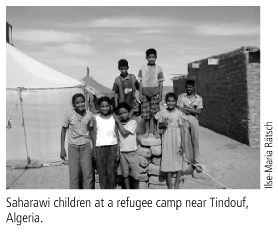In this months Bulletin
Trends in maternal mortality no cause for optimism
Attempts to measure maternal mortality suffer from a lack of good data. Using indirect indicators associated with maternal mortality the proportion of births assisted by trained birth attendants and the proportion delivered by caesarean section AbouZahr & Wardlaw (pp. 561568) examine trends in maternal mortality since 1990. The data suggest that there has been some improvement in parts of the Middle East and North Africa, in Latin America and in Asia. In sub-Saharan Africa, however, the indicators paint a sombre picture of slow change, stagnation or even reversal. Overall, it looks like an uphill struggle all the way.
Hypertension, a burgeoning burden in poor countries
By 2025, most elderly people in the world will be living in developing countries. Hypertension, one of the commonest diseases of the elderly, is thus likely to pose a considerable burden on these countries. A cross-sectional community-based survey, undertaken by the Hypertension Study Group (pp. 490500) to determine the prevalence of hypertension among the elderly at 2 sites in Bangladesh and 3 in India, found that 65% of the 1203 elderly individuals surveyed had hypertension and only 45% were aware of the fact. Of the 40% of hypertensives taking medication, only 10% were receiving adequate treatment. The authors suggest that developing countries that have, as India does, a nationwide network of community health centres should use them to screen opportunistically all elderly patients for hypertension.
Satisfying the customer
Client satisfaction is increasingly taking its place, even in developing countries, alongside quality of care and cost-effectiveness among the criteria used to assess how well a countrys health system is looking after its users. Among 1913 randomly selected people interviewed as they left about 100 government health centres in northern Bangladesh, Mendoza Aldana et al. (pp. 512517) found that the respect and politeness shown to patients by health centre staff were more important determinants of patient satisfaction than the staffs technical competence. Moreover, shorter waiting times, which averaged about 30 minutes per patient, were more important than longer consultation times, which averaged about two minutes per patient. Privacy was important to about a fifth of those interviewed, although it was denied to over a half. All in all, though, things werent too bad in northern Bangladesh more than two-thirds of users expressed overall satisfaction with the services supplied.
Battling genital ulcers to cut HIV cases
The evidence continues to grow of a strong link between sexually transmitted diseases, notably genital ulcer disease (GUD), and HIV/AIDS. OFarrell (pp. 569577) adds to the evidence the findings of his Medline literature search for the period between 1966 and August 2000, which revealed a strong positive correlation between the prevalence rates of GUDand HIV/AIDS in Africa. Countries least affected by the HIV/ AIDS epidemic in West Africa, particularly had far lower rates of GUD than those most affected, notably in southern Africa. The correlation also held for two areas within South Africa, where differing HIV/AIDS rates went hand-in-hand with differing GUD rates. Interventions specifically targeting GUD, the author insists, could make an impact on HIV/AIDS where high prevalence rates for the two conditions coexist. Declaring GUD a public health disaster in heavily infected areas of the world might, says the author, focus much-needed attention on this important HIV risk factor.
Measuring anaemia
In south-east Asia, anaemia is still a public health problem, affecting 2080% of individuals at risk. Prevalence figures, however, can vary with the method of measuring blood haemogloblin concentration. The method universally accepted as the most reliable is the so-called direct cyanmethaemoglobin method. However, it requires a laboratory equipped with a spectrophotometer within not more than a few hours travelling time from the site of blood collection, and all samples must be measured by the same laboratory. In a study conducted in Indonesia involving 121 mothers, Sari et al. (pp. 506511) compared two alternative methods: the indirect cyanmethaemoglobin method, whereby blood is dried on filter paper and re-dissolved in a laboratory before measurement, and HemoCue, a new-generation haemoglobin photometer that is easy to use in the field and entails little inter-observer error. HemoCue, the study showed, is more accurate than the indirect method, which overestimated the prevalence of anaemia by a factor of 2. Its considerable cost, however, could limit widespread adoption.
Saharawi children and coeliac disease

People with coeliac disease are unable to digest gluten, a protein found in wheat, rye and barley. This largely genetic disorder, which affects 0.51% of people in developed countries, is 5 to 10 times more common among the Saharawi, a highly inbred population originally from Western Sahara. Many Saharawi who fled political disturbances in the 1970s now live in Algerian refugee camps. In a study on coeliac disease among Saharawi children living in one such camp, Ra¨tsch & Catassi (pp. 541545) found that a group of affected children suffered disproportionately from bronchitis, poor appetite, fever, vomiting, abdominal pain and distension. The crux of the problem is that the Saharawi diet, originally consisting mainly of glutenfree foods, such as camel milk and meat, dates, and sugar, now comprises mostly bread and gluten-containing cereals. The authors are pursuing a project that seeks to incorporate gluten-free cereals, such as rice and millet, into the staple diet of Saharawi children with coeliac disease.
